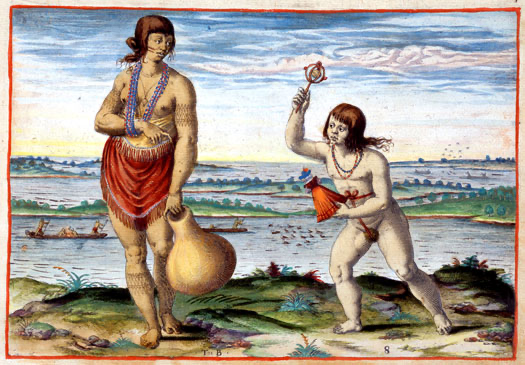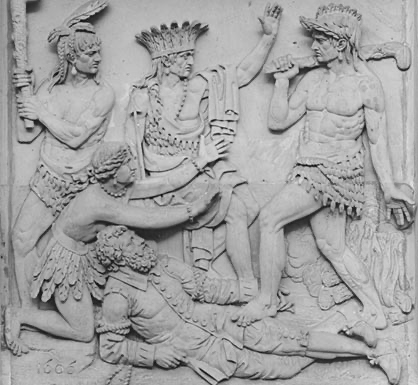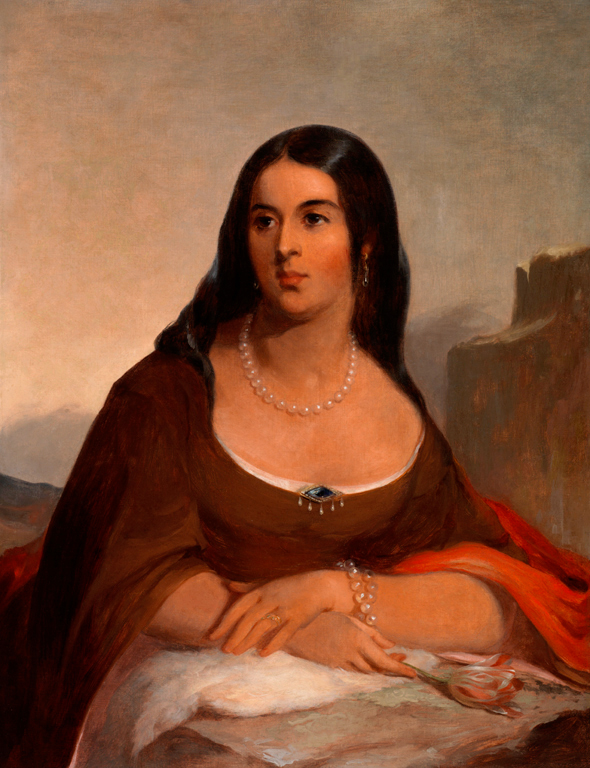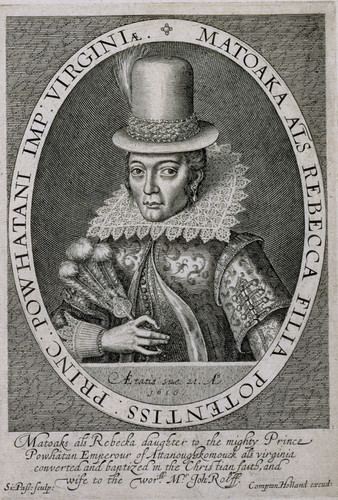5 American Impressionists You Need to Know
Impressionism is an art movement that originated in France in the 19th century. Artists associated with this movement are known for their dream-like...
Ruxi Rusu 16 September 2024
If you ask any kid in America who Elizabeth Cady Stanton was, you’ll probably get a silent stare. Mention Pocahontas and the majority will light up their faces remembering the Native American princess who saved an Englishman. For more than 400 years, marketing and film industries have exploited her likeness to benefit their own interests, modifying Pocahontas’ narrative and shaping her appearance to the public. Only recently alternative stories have shed some light on this idealized figure. Pocahontas’ true story can be found in art history. It will help us to see the real person behind the popular Disney face.

Pocahontas is a 1995 Disney film based on the English written history of the colonization era about a princess of the Powhatan tribe. In the animated movie, Pocahontas’ personification is idealized, with delicate physical features while maintaining Native American characteristics.
Artistic representations of Pocahontas are endless, from paintings to sculptures, from film to written novels. She is the main character in stories of colonization and seems to represent both sides of the tale. The Western view of history gained ground since the movie industry began to depict the character. Just recently, the keepers of the oral tradition of the Powhatan tribe have raised their voices to speak an alternative truth of Pocahontas’ true story.
Below you will find a few facts that you need to know about Pocahontas’ true story:
Matoaka, which means “flower between two streams” was the name given to Pocahontas when she was born in 1595. She sadly lost her mother during childbirth who was the first and favorite wife of the tribal leader Powhatan Wahunsenaca and was named Pocahontas. Her father sometimes referred to her as Pocahontas in memory of his beloved lost wife while his daughter was raised by different women. Interestingly, when a Powhatan leader became a chief his duty was to marry women from different tribes to seal the alliance between American nations.

This colored engraving can shed some light on how Pocahontas would have appeared as a young girl and later as an adult. The engraving is based on watercolors painted by John White, an English artist and explorer who lived among native Virginians in 1585-1586, roughly a decade before Pocahontas’ birth. According to White’s images and related text, a Powhatan girl wore no clothing before puberty. From about the age of 12 years old, she wore a deerskin skirt, perhaps decorated with beads or carved with figures from nature. Powhatan women also adorned themselves with tattoos and body paint derived from roots, as well as necklaces, bracelets, and earrings strung with freshwater pearls, shell beads, copper, animal teeth, or beads of bone.
Moreover, as a child, considering the position Matoaka held in the tribe, she never wandered around the wilds unsupervised, as she is depicted in doing so in many stories.
The relationship between an Englishman, John Smith, and Matoaka was initiated when she was just a little girl. The connection between the two started when the tribe sent supplies to the English town of Jamestown. The Powhatan community saw the English as a good ally to fight the possible arrival of the Spanish colonists, infamous for their mercilessness towards American tribes. As a sign of peace, Powhatan would send a child with the food, to demonstrate that the meeting was meant to be friendly. Matoaka was a friendly and curious child and she probably shared some words with the Englishmen in order to learn the language, possibly meeting John Smith in these moments.
Captain John Smith was not quite honored by the English community. He was a survivor, used to a hard life, not a hero as it is depicted in films. He led different positions among the colonists, and while he conducted an expedition throughout the region, he was captured by the Powhatan tribe. What happened there was what gave him an important position in the Pocahontas true story.
Smith was brought to the Powhatan chief, Pocahontas’s father. Most historians believe that the Powhatan people conducted an adoption ceremony, welcoming Smith into their community and the captain did not understand this. Also, historians believe Pocahontas was too young to be around at the ceremony, as children were not allowed to be present.

When Smith returned to Jamestown on friendly terms with the tribe, they maintained contact with him by bringing him food. Because Smith was responsible for his companions’ deaths during their capture, he was sentenced to execution by hanging. On the night of his execution, new settlers arrived in Jamestown and freed him from being killed. So in fact it was the colonists who planned to kill Smith, not the Powhatan tribe, and it was the Englishmen who saved Smith from death, not Pocahontas.
Later on, when Smith returned to England with several wounds, he wrote a book called The Generall Historie of Virginia, New-England, and the Summer Isles in 1624. In the book, he recounted the story of Pocahontas as his savior. When Smith wrote the tale, Pocahontas was already famous, and she was visiting England at the time. It seems doubtful to believe that Smith was writing a real experience more than trying to make his story extra appealing.
Smith’s book created the prototype of the Disney Pocahontas that artists copied incessantly. Some representations came to be after the publication of the book, but it wasn’t until the early 19th century that her status as a mythic figure took flight. This sandstone carving in the U.S. Capitol Rotunda is a great example. By 1825, the rescue of Smith had been popularized in romantic novels, biographical dictionaries, and dramas such as The Indian Princess.
It had also become entwined in the founding of the American Republic, befitting a subject for the Capitol building. Sculptor Antonio Capellano made his relief simple and bold to ensure the story was readily identifiable in the sculpture’s location high above the western door of the rotunda.
This widely exhibited oil painting of Pocahontas (above) is probably the least accurate representation of a Native American person. Her dark skin and black hair have become white and brown respectively, and her facial features were made more delicate. Even if this painting was probably made while Pocahontas was alive and visiting England, the painting is based on the only representation of her made from life, that is an engraving by Simon van de Passe (shown at the end of the article).

This painting shows Pocahontas after being abducted by the English colonist. Again, her skin color is relatively light and her facial features are delicate. She is wearing jewelry and expensive clothing, an expression of European upper-class society. The landscape represents American nature, almost stating that she was the mother of the American land. In the 1850s, different ideologies flourished among Americans and the political sphere was starting to get tense. 200 years after Pocahontas’ death, the figure was still used for political purposes, and this time was to commemorate the progenitors of the Nation.
In the Powhatan tradition, becoming a woman in the tribe is followed by choosing a new name. Matoaka chose Pocahontas and married a prestigious warrior, Kocoum. Her connection with the English colonists has been reduced since the relationship between Native Americans and colonists began to grow tense. The English interested in Pocahontas’ position in the tribe decided to kidnap her. Historians connect this scheme to Captain Samuel Argall.
The new colonial leader, Argall, wanted to hold Pocahontas to ransom for the return of English prisoners and weapons. Even if the ransom was paid for, Argall and the new colonialists never returned Pocahontas as a strategy to obtain whatever they wanted from the tribe. They converted Pocahontas to Christianity and baptized her as Rebecca. It is widely believed by the Powhatan tribe that Pocahontas submitted to the English in order to protect her people, to maintain the peace. Whatever her intentions were, she married an English settler, John Rolfe, the first settler to introduce tobacco in the area.

This monumental, 12 x 17 feet (5.18 x 3.66) mural, received a prestigious commission in 1836 and the author researched the subject with interest. However, the scant historical record and, more critically, Chapman’s cultural prejudices led to a largely imaginary scene. Chapman was a Virginian and may have chosen the subject, in part, to respond to New Englanders of the day who argued that their “Pilgrim” forefathers established the moral foundations of the Republic.
He represented Virginia’s founders giving credit to their missionary effort: Pocahontas, sanctified in a white dress and kneeling like the Virgin Mary, renouncing her Powhatan ways. In a pamphlet on his painting, Chapman noted that Jamestown’s colonists did not “exterminate the ancient proprietors of the soil, and usurp their possessions.” Rather, they spread “the blessings of Christianity among the heathen savages.”
During her stay in England, in Pocahontas’ true story, she met all the dignitaries who financed the Virginia Company to colonize America. Her function there was to represent the progress of the colonists in Virginia, by making alliances with the native tribes. This was the first depiction of Pocahontas intended to demonstrate that a Native American could adopt the behavior of a “civilized” European society. The engraving was commissioned by the Virginia Company to attract investors — representing a princess, the daughter of a tribal emperor, with the ostrich feather in her hand as a symbol of royalty. This is the soundest representation of Pocahontas that exists.

This engraving is the only known portrait of Pocahontas rendered from life. During her stay in England, Dutch engraver Simon van de Passe captured her likeness giving us probably the most accurate representation of her. It was the first of many depictions of Pocahontas intended to demonstrate the success of Christianity over “savage” Native Americans. The Virginia Company likely commissioned the engraving with this in mind, hoping to attract more colonists and investors. Therefore, the intention of this engraving was to promote the impression of Pocahontas as a European princess, attributing to her royal symbolism.
Pocahontas had a short life, as she was only 21 years old when her life ended in Gravesend, England. The reason remains a mystery, as there are contradictory sources about it. The majority of English texts stated that Pocahontas contracted a disease. The Native American oral tradition is that the Virginia Company poisoned her. Having contradictory sources makes the enigma of Pocahontas more intriguing and captivating.
The truth is we know very little about Pocahontas. She never kept a diary, wrote a letter, or told anyone her real-life story. The tribal oral traditions seem to be the most accurate representation of her own voice. What we know about her from artistic representations and novels seems to be part of a fantastic storyteller and political interest tradition. Her image changes considerably through time and even her name was a source of confusion. What we certainly know is that her persona is an important figure in the history of America for both Native American and English narrations.
Linwood Custalow and Angela Daniel: The True Story of Pocahontas the Other Side of History, Fulcrum Pub., 2007.
John Smith and others: The Generall Historie of Virginia, New-England, and the Summer Isles: with the Names of the Adventurers, Planters, and Governours from Their First Beginning. an: 1584. to This Present 1624. With the Procedings of Those Severall Colonies and the Accidents That Befell Them in All Their Journyes and Discoveries. Also the Maps and Descriptions of All Those Countryes, Their Commodities, People, Government, Customes, and Religion Yet Knowne. Divided into Sixe Bookes. By Captaine Iohn Smith Sometymes Governour in Those Countryes & Admirall of New England, 1629.
Helen C. Rountree: The Powhatan Indians of Virginia: Their Traditional Culture, Norman: University of Oklahoma Press, 1989.
Camilla Towsned: Pocahontas and the Powhatan Dilemma: The American Portrait Series, New York: Hill And Wang, 2004.
DailyArt Magazine needs your support. Every contribution, however big or small, is very valuable for our future. Thanks to it, we will be able to sustain and grow the Magazine. Thank you for your help!